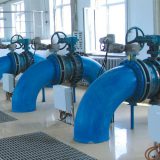In air conditioning and heating systems, cold or hot media is transmitted and distributed to users by closed pipeline systems. For a well-designed pipe network system, each user should be able to obtain the designed amount of water when the opening of sanitary regulating valve (electrically controlled valve, thermostatic valve, etc.) is 100%. And each user can not only obtain the required water flow, but also doesn’t interfere with each other when the opening of rear regulating valve changes. Such a water system is a hydraulically balanced system, otherwise it is a hydraulically imbalanced system, which is also known as hydraulic disorder.
Hydraulic disorder can be generally divided into static disorder and dynamic disorder.
Static disorder is also known as steady-state disorder. In the system, each user, under designed state, has discrepancies between actual flow and designed flow. This kind of hydraulic disorder is fundamental. If it’s not resolved, the impact will always exist. For a constant flow system, this disorder can be solved by a static balance valve or an electric two-way valve.
Dynamic disorder is also known as stability disorder. In the system, when some users’ water flow changes, there’ll be changes in the resistance distribution of the system, resulting in changes in the flow of other users. This kind of hydraulic disorder is random and dynamic. If the impact on other users by the change in local flow is small, then the degree of hydraulic disorder is small, and the hydraulic stability is good. The other way around, then the degree of hydraulic disorder is big, and the hydraulic stability is poor. This kind of disorder can’t be solved by a static balance valve or an electric two-way valve, it can only be solved by dynamic balance electric regulating valve.

